QR Code in Pharma: The Future of Seamless HCP Engagement and Digital Access
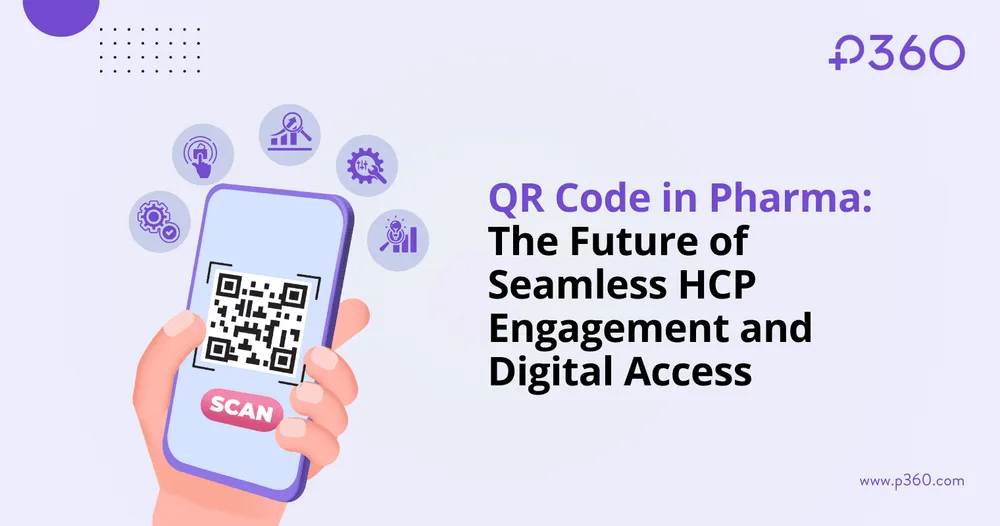
by Apeksha Motghare | Last Updated: July 14, 2025 | 1 min read
The pharmaceutical industry is in the middle of a digital awakening. From rep-driven visits to multichannel strategies, digital engagement in pharma has evolved rapidly over the past few years; especially post-pandemic. Traditional face-to-face detailing, once the gold standard, now competes with a flood of digital touchpoints. But despite all the new tools, one challenge remains: how to connect with healthcare professionals (HCPs) in a fast, compliant, and frictionless way.
That’s where the QR code in pharma is proving to be a game-changer. Think about it, what if an HCP could instantly access approved content, training videos, or sample request forms, simply by scanning a code on a business card or product box? No app downloads. No logins. Just seamless access. This simple scan is unlocking a new era in pharma marketing with QR codes, making it easier than ever to deliver personalized, trackable content in seconds.
In fact, this small piece of tech is doing what bloated platforms and static PDFs couldn’t; it’s bridging the last-mile gap in digital engagement in pharma. As we explore this trend further, we’ll uncover how the QR code in pharma isn’t just a tech fad, it’s fast becoming the backbone of QR code use cases in healthcare across the U.S. pharma landscape.
QR Code in Pharma: A New Era of Instant Access
Quick Response (QR) codes have been around since the 1990s, originally created to track automotive parts. But today, they’re powering a new era of instant access in multiple industries, including pharma. At their core, QR codes are two-dimensional barcodes that store data and link directly to digital content. When scanned using a smartphone camera, they trigger an action, like opening a webpage, downloading a file, or launching a video. It's simple, fast, and doesn't require an app or login.
So, why the sudden surge in QR code in pharma? The answer lies in the growing demand for frictionless, on-demand information. In a world where HCPs are pressed for time and overwhelmed with information, traditional engagement tools are losing ground. That's where pharma marketing with QR codes comes in, offering a fresh, convenient way to connect with healthcare professionals.
Whether printed on packaging, brochures, business cards, or even product samples, QR codes can instantly guide HCPs to:
-
Approved digital content
-
Clinical trial results
-
Sample request forms
-
Training videos
-
Patient education material
This shift toward QR code in pharma is being driven by its clear advantages:
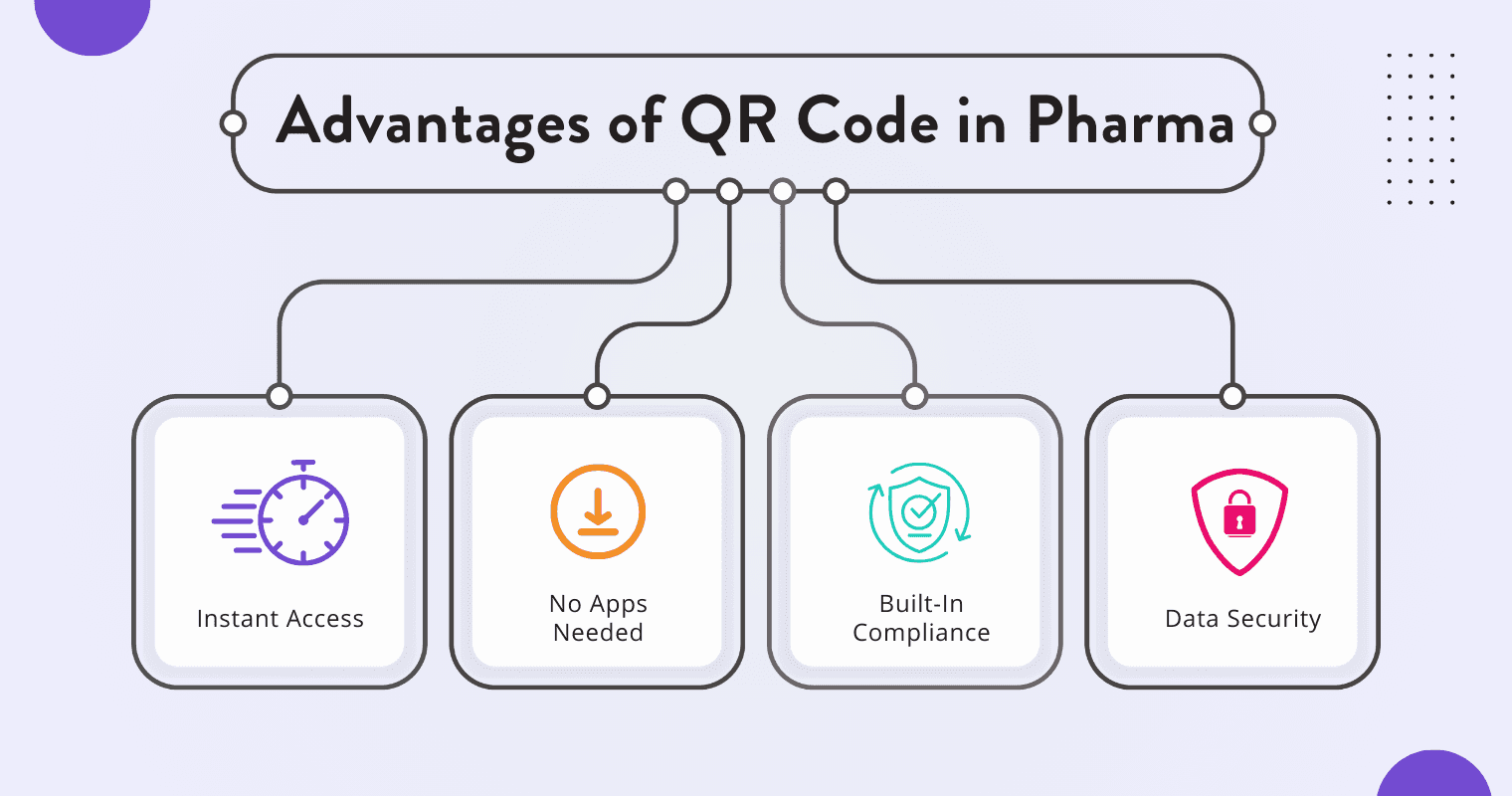
-
Instant Access: HCPs can scan and view information in seconds, at their convenience.
-
No Apps Needed: No installations, passwords, or device restrictions, just scan and go.
-
Built-In Compliance: Codes can be linked to pre-approved, region-specific content, reducing off-label risks.
-
Data Security: With proper backend controls, content delivery remains secure and trackable.
From field sales reps to medical affairs teams, everyone is rethinking how to engage HCPs through digital engagement in pharma. And the trend is only accelerating, with QR code use cases in healthcare expanding across therapeutic areas and specialties.
Simply put, the QR code in pharma is no longer just a tool, it’s becoming a strategic pillar of future-ready HCP engagement.
Explore More Relevant Articles on P360
- Two-Way Messaging in Pharma: Engage HCPs in Real Time
- Two-Way Messaging in Healthcare: A Guide to Secure, Real-Time Engagement
- Approved Content Management in Pharma: A Compliance-First Approach to HCP Engagement
- New White Paper: Unlocking the Power of Two-Way Messaging in Pharma
- Approved Content Management in Pharma: A Compliance-First Approach to HCP Engagement
Why Pharma Marketers are Turning to QR Codes

In today’s fast-paced healthcare environment, pharma reps are under constant pressure to make their limited time with HCPs count. Face-to-face interactions are fewer, and even when they happen, they are often brief and highly regulated. This shift has pushed pharma marketers to rethink how they deliver value, quickly, efficiently, and on the HCP's terms.
Enter the QR code in pharma. This simple tool is proving to be a powerful asset in pharma marketing with QR codes, offering asynchronous access to vital information. Whether it's a prescribing guide, patient education video, or a request form, HCPs can scan a QR code and engage when it suits them after clinic hours, between appointments, or even during a lunch break.
This model of digital engagement in pharma reduces the burden on reps while keeping them in the loop through trackable scans and content interaction metrics. In fact, QR code use cases in healthcare are expanding as marketers realize how flexible and efficient they can be.
With minimal friction, higher control, and improved convenience, it’s no surprise that QR code in pharma strategies are being rapidly adopted across leading brands.
Strategic Use Cases: Where QR Codes Make the Most Impact
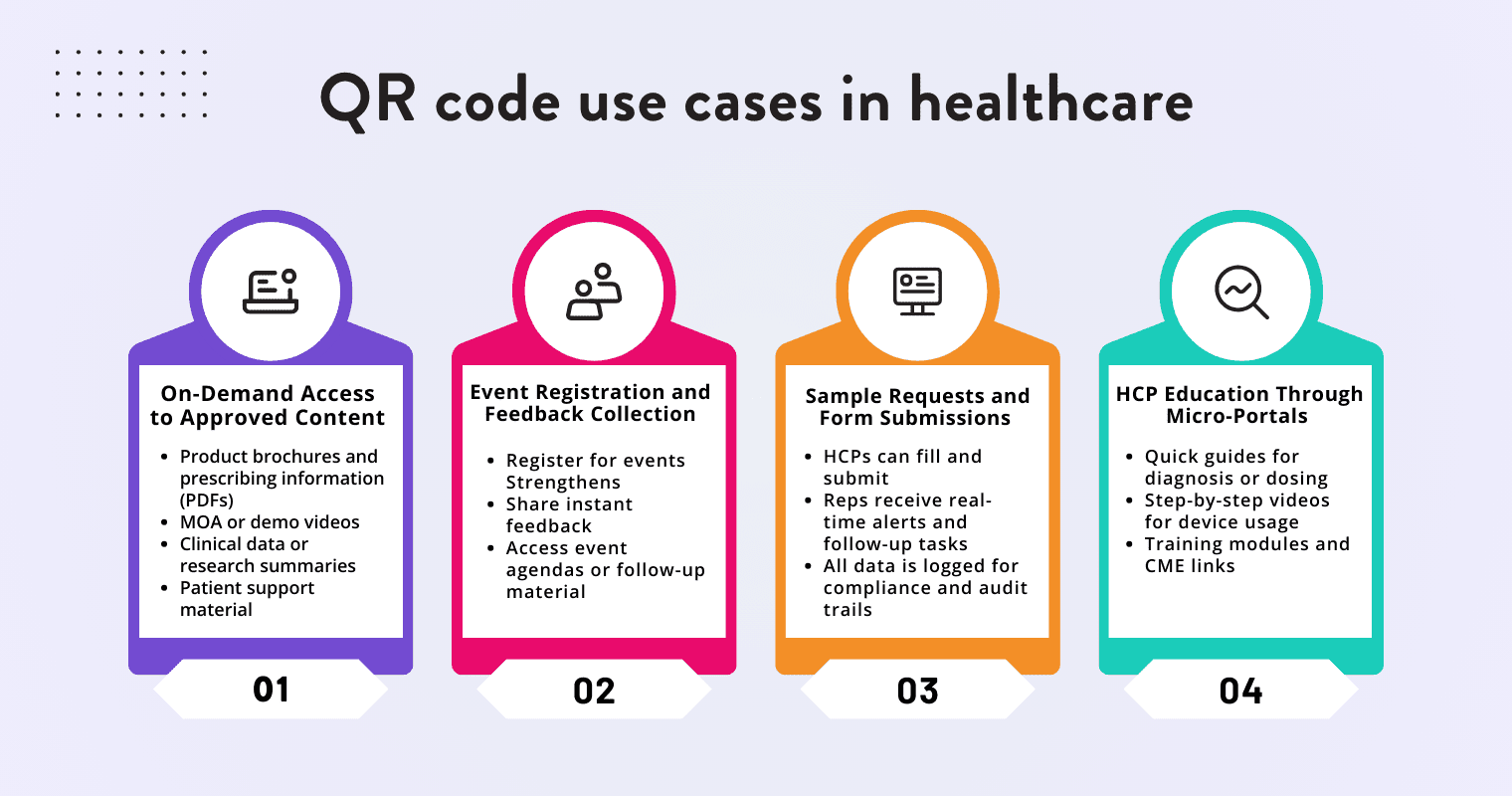
As industry embraces digital engagement in pharma, one tool stands out for its simplicity and versatility: the QR code in pharma. It’s more than just a bridge to a website, it’s a gateway to rich, compliant content that supports timely, effective interactions with healthcare professionals.
Let’s explore the most impactful QR code use cases in healthcare, especially within the context of pharma marketing with QR codes.
1. On-Demand Access to Approved Content
QR codes allow reps and marketers to share region-specific, pre-approved content like:
-
Product brochures and prescribing information (PDFs)
-
MOA or demo videos
-
Clinical data or research summaries
-
Patient support material
This ensures that every scan leads to compliant, relevant content while minimizing legal risk. Since the content lives on the backend, it can also be updated without changing the QR code itself.
2. Event Registration and Feedback Collection
At conferences, congresses, and speaker programs, QR codes offer a quick way for HCPs to:
-
Register for events in seconds
-
Share instant feedback via forms
-
Access event agendas or follow-up material
This improves event engagement while offering insights into what matters most to attendees.
3. Sample Requests and Form Submissions
One of the more operationally valuable QR code use cases in healthcare is streamlining sample requests and medical inquiry forms. With a single scan:
-
HCPs can fill and submit sample requests digitally
-
Reps receive real-time alerts and follow-up tasks
-
All data is logged for compliance and audit trails
4. HCP Education Through Micro-Portals
Marketers are now embedding QR codes into sales aids and packaging that lead to educational micro-portals. These portals include:
-
Quick guides for diagnosis or dosing
-
Step-by-step videos for device usage
-
Training modules and CME links
This level of digital engagement in pharma adds measurable value to every scan, while giving HCPs content that fits into their schedule.
When used strategically, the QR code in pharma becomes a lightweight yet powerful channel that transforms everyday interactions into impactful, data-driven touchpoints. It’s no wonder that pharma marketing with QR codes is gaining momentum across all tiers of engagement.
Digital Compliance & Control: Why QR Codes Are Safer
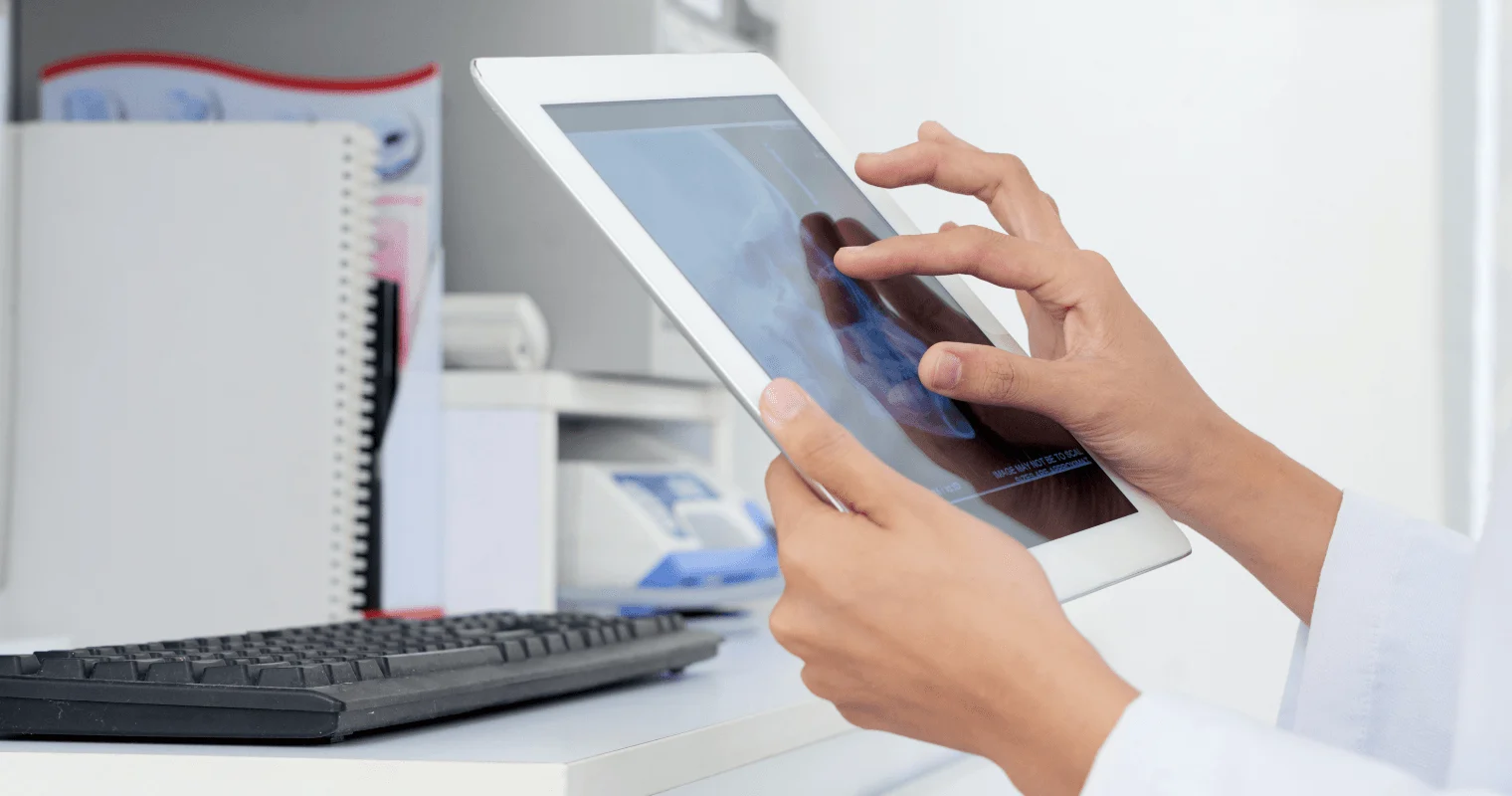
In an industry where compliance isn't optional, QR code in pharma solutions offer a smart way to balance innovation with regulation. Unlike email attachments or printed brochures, QR codes connect HCPs to centrally managed digital content, giving pharma companies full control over what’s shared, when, and where.
Centralized Content Control
With QR codes tied to a backend content management system, pharma teams can update or revise materials without reprinting anything. This reduces the risk of outdated or off-label content being circulated. Whether it’s product information, MOA videos, or prescribing guides, marketers can ensure every scan leads to the most current and approved version.
Reduced Risk of Human Error
Even the best-trained sales reps can make mistakes. By using QR code in pharma workflows, reps no longer need to explain every detail on the spot. Instead, they can guide HCPs to the right content instantly. This eliminates the risk of miscommunication, a common challenge in the field. It also improves consistency across reps, regions, and campaigns.
Built-in Compliance and Audit Trails
One of the key advantages of pharma marketing with QR codes is its traceability. Each scan can be tracked, time-stamped, and linked to specific content interactions. This builds a secure audit trail that supports compliance with industry regulations like FDA guidelines and Sunshine Act reporting.
In short, as digital engagement in pharma becomes more sophisticated, QR codes emerge as one of the safest and most scalable solutions. It’s no surprise that QR code use cases in healthcare are being embraced not only for access and speed but also for the control they offer behind the scenes.
Overcoming Adoption Barriers in Pharma
Despite the clear benefits, adopting QR code in pharma strategies doesn’t come without challenges. From initial skepticism to internal readiness, the path to implementation requires thoughtful planning and execution. But with the right approach, these hurdles can become opportunities for long-term success.
Winning Over HCP Skepticism
Some healthcare professionals are still cautious about scanning QR codes, especially when it comes to accessing sensitive medical information. Concerns around data privacy or irrelevant content often stand in the way. The solution? Deliver value immediately. When a QR code leads directly to concise, approved, and high-quality content, HCPs are more likely to trust and use it. Over time, consistent, value-driven scans can build credibility and increase adoption.
Empowering Sales Reps with the Right Training
Sales teams are critical to the success of pharma marketing with QR codes. It’s essential that reps not only understand the technology but also feel confident using it in the field. Training should go beyond how to generate or share QR codes. It must include practical scenarios that show reps how to position the QR code as a helpful tool during short, high-stakes engagements. This improves their comfort level and boosts digital engagement in pharma settings.
Seamless Integration Behind the Scenes
For marketers, backend infrastructure is just as important. To support QR code use cases in healthcare, the content management system must be secure, mobile-friendly, and easily updated. Integration with CRM platforms can help track usage and drive data-driven decisions.
When executed thoughtfully, these steps help organizations not only overcome adoption barriers but turn the QR code in pharma into a reliable and scalable engagement channel.
The Role of Analytics & Tracking
One of the biggest advantages of using a QR code in pharma is the ability to track engagement with precision. Every time an HCP scans a code, the backend system can capture valuable data, such as the time of scan, geographic location, device type, and user behavior. These insights help pharma teams understand what content resonates, when it's most accessed, and how often it’s being used.
For marketers and sales reps, this data opens the door to smarter decision-making. Imagine a sales manager being able to see which territories are engaging with a QR-linked product brochure more frequently or which time slots yield the highest interaction. This level of real-time visibility empowers pharma marketing with QR codes to become more agile and effective.
Beyond just monitoring clicks, the true value lies in personalizing the next steps. If an HCP scans a QR code and views a video on dosage instructions, the follow-up interaction can be tailored around that interest. This level of digital engagement in pharma helps build trust and relevance in every touchpoint.
Moreover, the insights support compliance reporting and optimize future campaigns. When used strategically, these QR code use cases in healthcare go beyond distribution, they inform a data-driven approach that enhances the entire HCP experience. With the right analytics, the QR code in pharma becomes more than a convenience. It becomes a feedback loop for continuous improvement.
The Future of HCP Engagement is a Scan Away
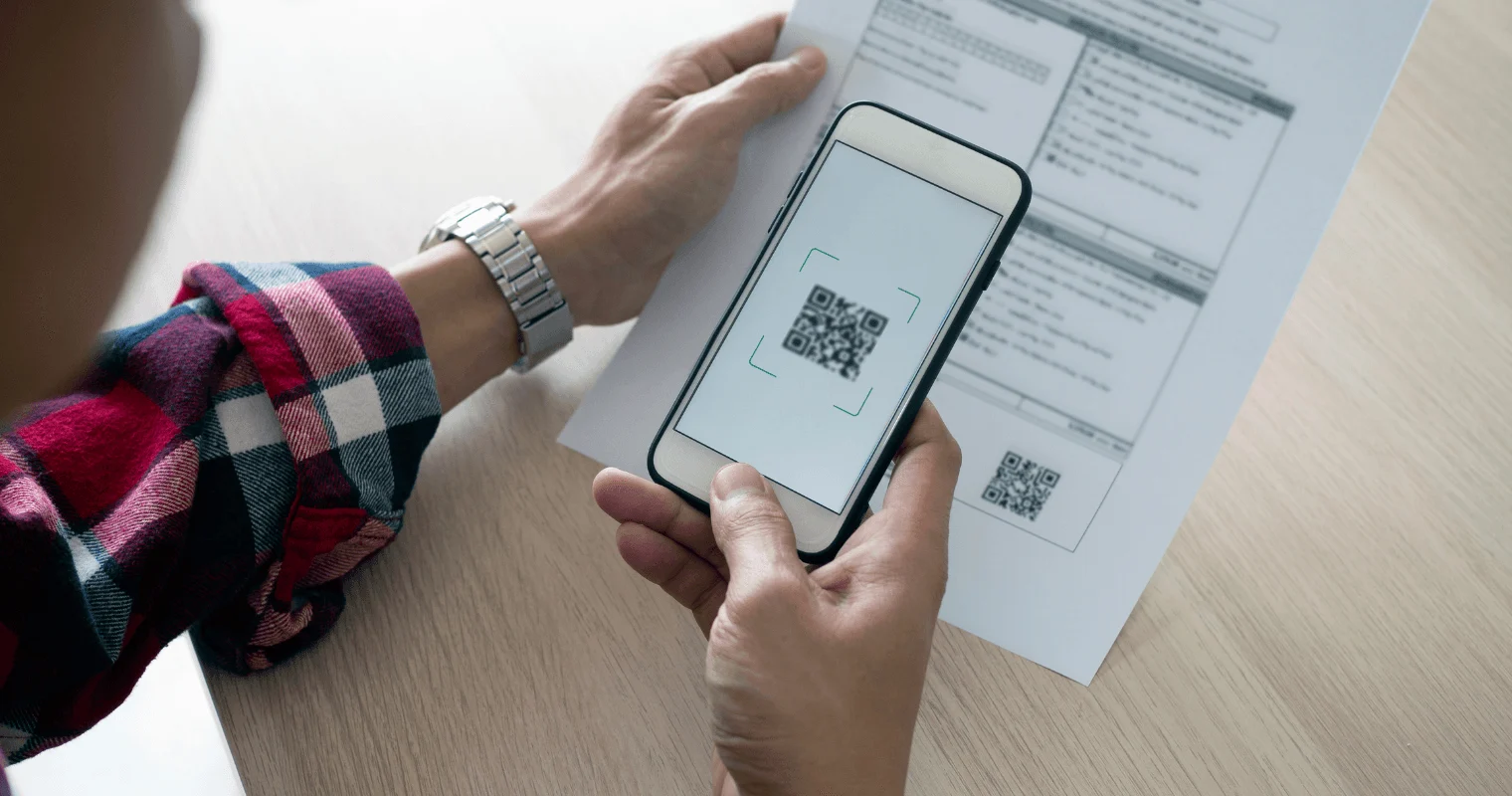
In today’s complex healthcare ecosystem, asynchronous engagement is quickly becoming the new normal. HCPs are busier than ever, juggling clinical responsibilities, ongoing education, and administrative tasks. As a result, real-time interactions with pharma reps are no longer the primary way to share product information. Instead, tools like the QR code in pharma are reshaping how and when that engagement happens.
Rather than relying on static email blasts or printed handouts, brands are now building dynamic, QR-powered journeys. With a single scan, an HCP can access a customized landing page, watch a mechanism-of-action video, or download a product monograph on their own time and device. This level of control aligns perfectly with modern expectations for flexible, fast, and relevant content.
By embedding QR code in pharma solutions across every touchpoint, from packaging and patient starter kits to booth displays and rep leave-behinds, companies are creating frictionless engagement loops. These codes are now becoming an essential part of pharma marketing with QR codes, serving as the digital front door to broader experiences.
When used as part of an omnichannel engagement plan, QR codes connect seamlessly with CRM systems, email automation tools, and analytics dashboards. This allows marketers to measure content consumption, retarget based on behavior, and continually optimize campaigns. It also supports compliance by ensuring HCPs always receive the most recent, approved content.
As these QR code use cases in healthcare continue to grow, the role of the QR code in pharma will only become more central to brand strategy. From improving digital engagement in pharma to simplifying rep workflows, the future of HCP engagement may truly be just one scan away.
Integrating QR Code Strategy with ZING from P360
To bring the full potential of a QR code in pharma campaign to life, execution must be seamless, secure, and scalable. That’s where the ZING Engagement Suite from P360 steps in. ZING is a purpose-built platform designed to simplify and enhance communication between pharma reps and healthcare professionals. It supports omnichannel outreach, approved content sharing, and real-time insights, all without the need for app downloads or complex integrations.
How ZING Powers QR Code in Pharma Campaigns
At the core of ZING’s capabilities is its ability to generate and manage unique QR codes for every engagement use case. Whether it’s sharing prescribing information, training videos, or educational content, each QR code is linked to dynamic, backend-controlled content. This ensures HCPs always receive up-to-date, approved material, something especially critical in pharma marketing with QR codes.
What sets ZING apart is the frictionless experience it provides for HCPs. They can scan a QR code and instantly access content with no app, no login, and no delay. This model aligns with modern expectations for speed and simplicity while meeting the high standards of digital engagement in pharma.
Key Benefits for US-Based Pharma Teams
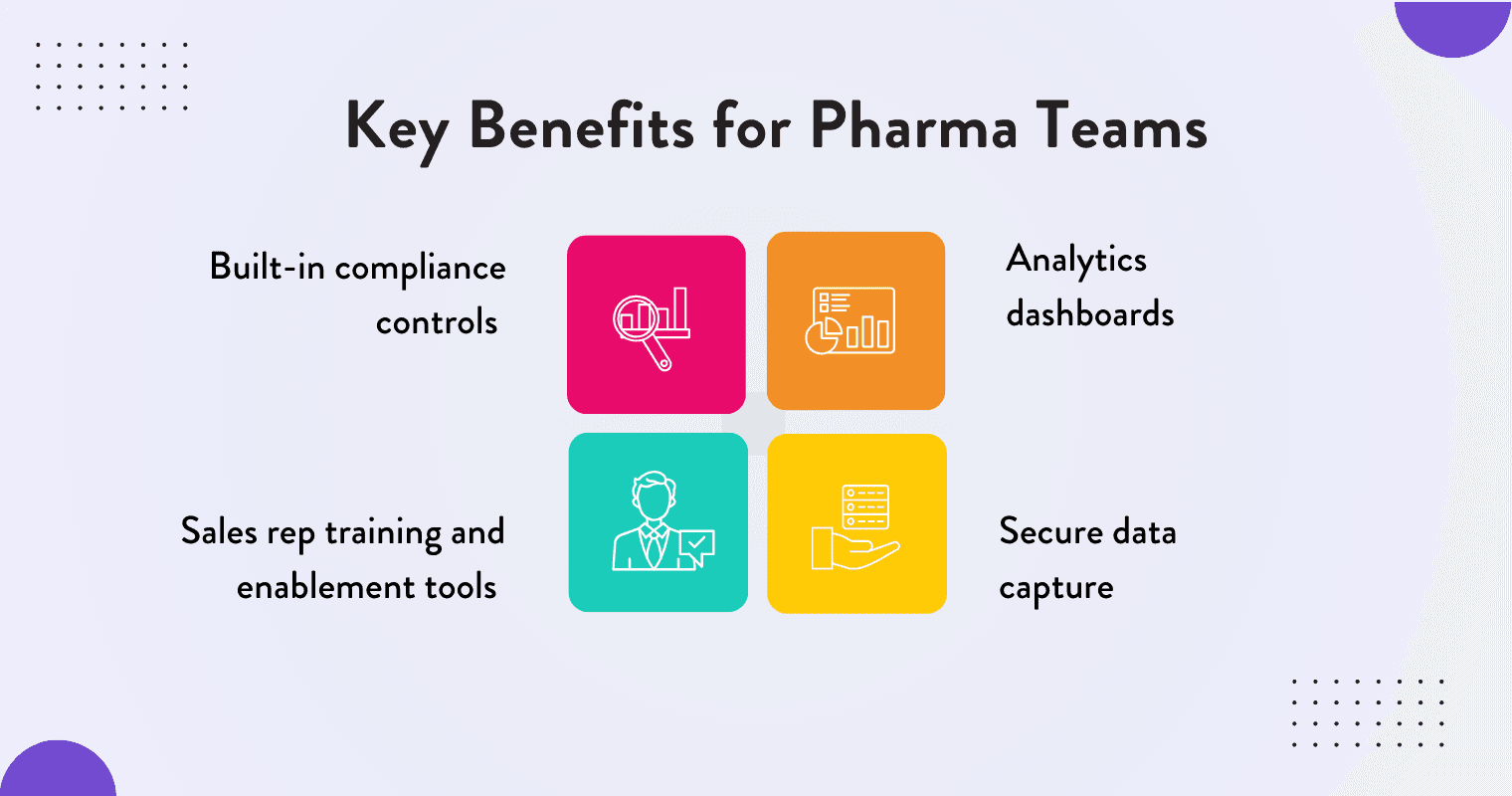
-
Built-in compliance controls that ensure only approved, region-specific content is shared
-
Analytics dashboards to track scan behavior and content performance
-
Sales rep training and enablement tools that integrate QR usage into daily workflows
-
Secure data capture that supports regulatory audits and internal reporting
As QR code use cases in healthcare continue to expand, platforms like ZING are making it easier for commercial and medical affairs teams to execute campaigns with confidence. The QR code in pharma is more than just a digital shortcut, it’s now a strategic tool for meaningful, compliant, and measurable HCP engagement.
Final Thoughts: Are You Ready to Scan Into the Future?
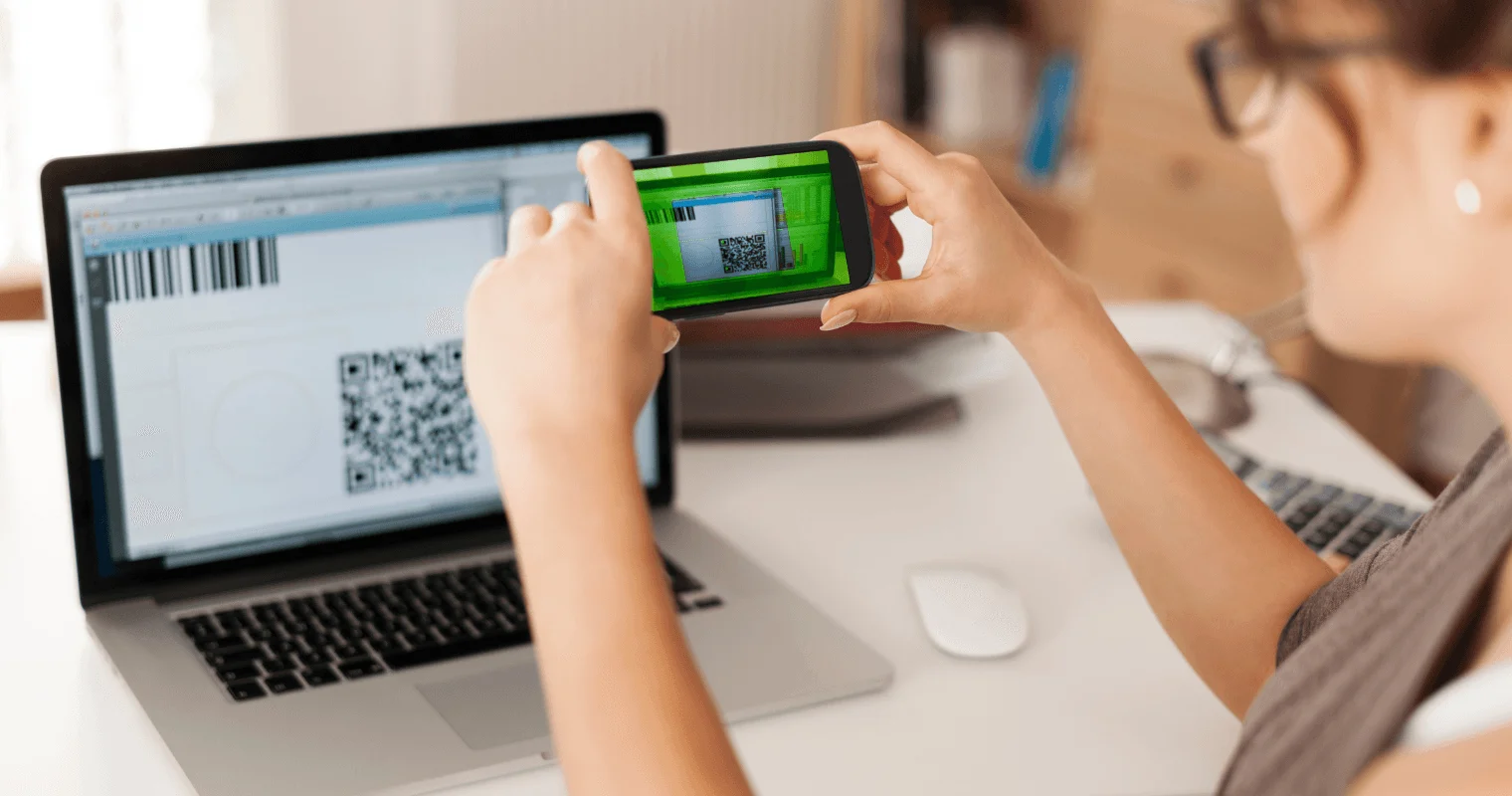
The shift toward QR code in pharma is more than a digital trend, it’s a practical solution to long-standing engagement challenges. From delivering instant, approved content to improving analytics and rep efficiency, the benefits are clear. With pharma marketing with QR codes, you can offer HCPs a faster, more flexible way to connect, while maintaining control and compliance.
As digital engagement in pharma continues to evolve, QR codes will play a central role in shaping the next era of personalized outreach. The question now is are you ready to scan into the future?